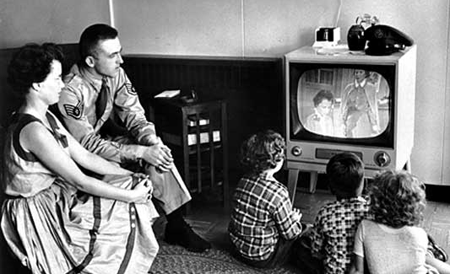Looking Back at `America in Primetime'

For the next month, starting this Sunday, PBS takes a most interesting four-week look back at America in Primetime, a production of the late Peter Jennings' Documentary Group, in association with the Academy of Television Arts & Sciences.
The series appropriately coincides not only with many PBS station fundraisers, but more portentously with the infamous November "sweeps" period, which will decide what new shows get a January renewal, and which shows will fade to black for good, in the commercial TV sphere.
America in Primetime is the latest in PBS' recent explorations of our small-screen sociopolitical scene, coming on the heels of the second batch of their Emmy-nominated Pioneers of Television specials (which, full disclosure -- I worked on) and which aired in January and February in most markets. (A prior season ran in early 2008.) The difference being largely that while the star-studded Pioneers focused on genres of programming (talk/variety and game shows, sitcoms, crime dramas, Sci-Fi, Westerns, and so forth), Primetime utilizes more of an "auteur theory" towards TV producer-writers and showrunners, as well as the stars, and zeroes in on the different archetypes and themes explored on television.
The premiere episode (Oct. 30th on most PBS stations, with reruns during the week) focuses on "The Independent Woman", tracking the evolution of women on the small screen from zany housewives like Lucy Ricardo and Laura Petrie to high-powered executives like Murphy Brown, the Grey's Anatomy gals, and The Good Wife. And perhaps most importantly, the transitional figures -- Mary Tyler Moore's immortal Mary Richards (and today's flashback proto-Mary, Elizabeth Moss' Peggy Olsen on Mad Men), followed by working-class heroine and "domestic goddess" Roseanne.
Episode Two (Nov 6th), flips the coin to "The Man of the House", focusing on sitcom daddies and family patriarchs, from fathers of the year like Ward Cleaver, Father Knows Best, Cliff Huxtable, and Ray Barone, to edgier dads like Archie Bunker (and his near-antitheses, gay papa bears Cameron and Mitchell on Modern Family.) The series' third installment (Nov 13th), mines the rich territory of high school and college horrors and TV's freaks and geeks, from Gilligan of Gilligan's Island to producer/screenwriter Vince Gilligan's creation on Breaking Bad, in "The Misfits".
But it's the fourth installment that saves the best for last, especially from a political or social point of view, in the somewhat mistitled Nov. 20th finale, "The Crusader". While a "crusader" might suggest Dr. Quincy or Lou Grant tearing some bureaucrat or abuser a new one in a Very Socially Relevant Episode, or a white-hat hero like Perry Mason, Marshal Dillon, or Joe Friday (who are used as contrasts), the real focus here is on TV's more recent, deeply flawed, often anti-social anti-heroes.
From Jack Bauer's impossible moral dilemmas between torture and murder on one hand and stopping global terror and assassinations on the other on 24, to the frankly abusive and beyond-politically-incorrect policemen like NYPD Blue's Det. Sipowicz and The Shield's Vic Mackey; from crime-causer Tony Soprano and white-collar sociopath Don Draper to Andre Braugher's tortured tour-de-force as an African-American Jesuit Homicide (Life on the Streets) sergeant. All of them, searching for the meaning of life (and often coming up empty) amongst their parade of ruined lives and helpless victims, doing the dirty work and cleaning up the messes most of us would rather avoid or pretend weren't there. This episode is especially "must see" TV for small-screen sociologists and politically-minded viewers.
The only major drawback of the documentary is the amount of material left behind, which many discerning viewers and TV aficionados might notice. While M*A*S*H, All in the Family, and Mary Tyler Moore are covered (and how could they not be?), the series essentially flashes from the beginnings of modern television to the present (mid-to-late 1990s to today) with little bridgework in between.
An episode on TV's "Independent Women" without reference to Angie Dickinson's Police Woman, The Avengers' Emma Peel, or even That Girl or Cagney and Lacey? A "misfits" episode minus Jimmie Walker from Good Times, Lieutenant Columbo, Mr. Spock, or Al Bundy? Even in the last episode's hall of TV heroes, the likes of Kojak, Cannon, Mannix, Captain Kirk, Steve McGarrett of Hawaii Five-0, Jim Rockford --even Thomas Magnum and the Hill Street Blues -- are almost nowhere to be found.
However, this is a query which I point out mainly because, having worked on programs like these, I can say firsthand that one of the most painful and tiresome parts of the writing and editing are the decisions of what to leave on the cutting room floor. More often than not, one is writing with the eraser as much as the pen. And for better or worse, there's no narration -- and fortunately no heavy-handed or shoehorned theories, either. America In Primetime lets the storytellers (the actors and producer/writers) tell the stories.
The documentary does seem top-heavy on cable offerings of recent years, reflecting PBS's similar upscale-educated demographic (which cable shows crave), although especially in its final installment, top-quality networkers like House, Twin Peaks,and NYPD Blue get equal billing.
More than anything else, though, America in Primetime succeeds in provoking fodder for discussion and argument within oneself as well as "with" the programs itself, about what is and isn't there, as well as with any interested family and friends. Just like -- I hope -- a good movie or TV review occasionally does.
America in Primetime runs October 30 through November 20 on PBS, check your local listings.

